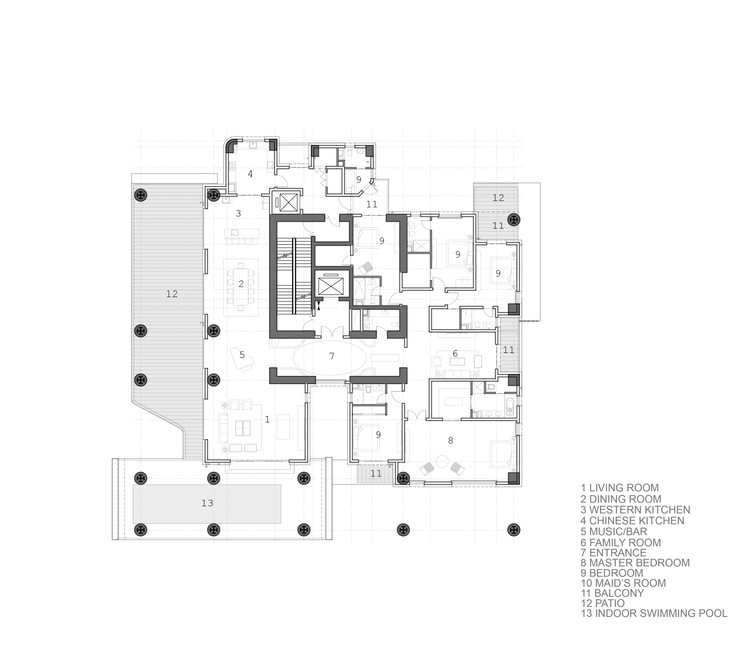
-
Architects: Amphibianarc
- Area: 21500 m²
- Year: 2017
-
Photographs:Zhejia Dai
-
Lead Architects: Nonchi Wang, Luoya Tu

Text description provided by the architects. Hanhai Luxury Condominiums consists of 215,000 m2 of built area divided up into twelve high-rise residential towers with subterranean parking, two semi-public club houses and a nine classroom kindergarten arranged around a central garden space, carefully sited for solar exposure and views of the adjacent waterway. The residences are organized by unit size, with towers containing 90 m2, 180 m2, 220 m2, 330 m2, and 650 m2 units each respectively. The club houses include amenities such as a café, tea house, gymnasiums, locker rooms and a pool, and retail establishments. The main club house will also function as the project’s sales center on an interim basis. Coupled with the kindergarten facility, these elements provide many amenities on-site and all within walking distance to the residents.

The project is located next to the city’s CBD area, and it is positioned to compete in the region’s high-end residential demographic, with the goal of becoming a leader in this project type. As such, our design looks to an amenity and feature rich project which provides a unique and luxurious environment to attract an exclusive clientele.

The design draws inspiration from concept of the “cloud”. It represents the design concept of combining nature with human lift. Meanwhile, the design team also extends the concept of all-intelligent “cloud” community to the architectural design visually. The building facade design uses large areas of dark glass that stand in sharp contrast with the sleek white terraces and balconies, highlighting a spirit of dynamic lightness for the overhangs visually. The tower building’s design features are extended to the design of the three facility buildings, which also emphasize organic shapes and sleek lines. Each building looks like a group of peaceful cloud in sky.

The primary consideration for the building design was to create a residential development which set itself apart from the typical high rise residential complex found in the City. This goal is accomplished on two fronts, by architectural design and by programming. The programming is accomplished through the inclusion of high-end luxury amenities within the units and the site, and by providing residential units with large areas. Through the architecture we break down the massing and repetitiveness usually found in this type of construction by producing visual ambiguity in the size and type of residential units from an exterior view. This ambiguity is created by giving the residential towers the illusion of large expansive glass walls through the use of a hybrid curtain wall system of glass and aluminum panels. This hybrid system is used to mask the punched stacked openings of typical residential construction and blur the distinction between solid wall and opening. The ambiguity is reinforced by the exterior balconies and patios, which swoop from floor to floor, turn around corners at different points, and extend in various lengths along the building faces.

The residential units have been designed for privacy and comfort with ample opportunity for cross ventilation and multiple spaces with good solar exposure. The large private terraces and small balconies bring the landscape to each unit, and the terraces allow each unit to expand the living spaces into the outdoors through the use of large sections of operable glass walls. This strong connection to the outdoors and landscape help meet the goal of providing each residence the feeling of a garden villa, only in the sky. Special features for the larger unit types include double height living spaces, double master suites, western and Chinese kitchens, bathrooms, and terrace swimming pools.


Beyond amenities and features, a design leading presence is called for. The balconies and terraces are carefully placed on the buildings and articulated to maximize the benefits to the interior while also breaking up the mass and repetitiveness of the 100m towers. The club houses and kindergarten buildings continue to define the design aesthetic by creating a visually dynamic statement, aimed towards the adjacent main roadway, canal, and University District.

The glass and aluminum panels are designated to be finished with dark colors, the synthetic stone and plaster are designated to be in white. Material colors are selected to provide a strong contrast between the dark mass of the basic residential building forms and the light playfulness of the expressive balconies and curving building forms of the lobbies, clubhouses and kindergarten. At the residences, the glass exterior finish extends beyond the top and bottom of any window openings to give the illusion of floor to floor glazing, broken up only by a thin band of synthetic stone at the floor line. The strong contrast between forms and the blurring of the distinction between what is solid and what is open further set the project apart from the typical.



































